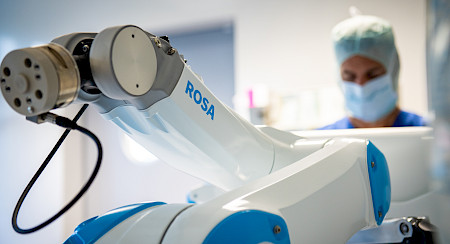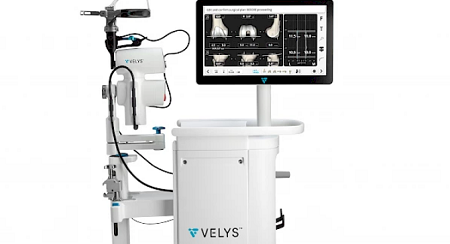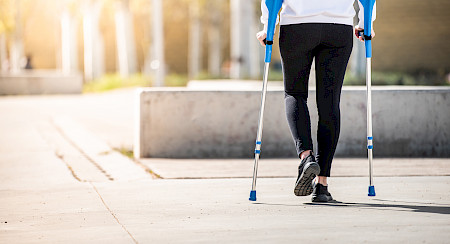- Accidents
- Overweight
- Malformations
- Joint-emphasised sports and occupations
- Metabolic diseases
- Chronic inflammation (e.g. rheumatism)
- Natural ageing process
close search
Osteoarthritis is an incurable joint disease in which the cartilage breaks down irreparably. It may occur in various joints but is particularly prevalent in the hip and knee. Osteoarthritis can be treated both conservatively and surgically (prosthesis).
Treatment choice depends on the severity of the joint degeneration and how it affects a person's quality of life.
Osteoarthritis is a progressive and irreparable degeneration of joint cartilage. It is the most common joint disease in adults worldwide and is favoured by the natural ageing process, among other things. Osteoarthritis occurs most frequently in the knee and hip joints, although other joints can also be affected, such as the finger joints or the shoulder joint.
Osteoarthritis is incurable, but for some years now there have been very good and promising conservative therapies that can slow down its progression to such an extent that surgery can be delayed or, in some cases, avoided altogether.
Osteoarthritis is usually caused by a combination of different factors that allow joint wear and tear to progress. Some causes can be actively tackled by those affected.
Osteoarthritis leads to pain and restricted movement. The pain often occurs with strain or certain movements. In the case of finger or shoulder osteoarthritis, rotational movements can cause pain. In contrast, knee or hip osteoarthritis often leads to so-called start-up pain after long periods of rest or radiation. Other signs of osteoarthritis can include heating or stiffening of the joint, loss of strength, swelling and muscle and tendon tension. At an advanced stage, these symptoms can greatly reduce the quality of life of the person affected.
In the early stages, osteoarthritis primarily leads to joint inflammation. Mechanical problems due to cartilage reduction can occur later on. The disease usually progresses in episodes and can be treated well at all stages. Both conservative and surgical methods are used. It is important to understand that pain and everyday limitations are perceived by osteoarthritis patients differently. The personal life situation and the perceived burden therefore influence the choice of the right treatment method.
If suffering from symptoms of osteoarthritis, it is recommended to consult an orthopaedic specialist to slow down the progression of the disease or take surgical measures to alleviate the suffering and everyday limitations.
Osteoarthritis is the most common reason why older people are not physically active anymore. Because of the pain, they often adopt an instinctive protective posture, which is well-intentioned but suboptimal. Exercise is important, even for osteoarthritis patients. It promotes the supply of nutrients, which ensures that the tissue remains intact and elastic.
If the pain is minimal and the joint is still functioning adequately, targeted training can be used to strengthen the neighbouring muscles, which reduces the pressure on the joint. The GLA:D® programme is a proven method in physiotherapy. The aim of this programme is to maintain or improve the quality of life of osteoarthritis patients and to delay or avoid surgical interventions. The programme can be supplemented by physical therapies or orthopaedic aids such as insoles.
Infiltration therapies are also used for more severe pain. In these, the joint inflammation is relieved with the help of hyaluronic acid or autologous conditioned blood plasma.
If osteoarthritis is very advanced, a prosthesis can provide relief, depending on the joint. Pain-free movement and mobility are usually no longer possible at this stage, which greatly restricts the quality of life of those affected.
Surgery today is gentle and, depending on the joint, minimally invasive, whereby the surrounding tissue, muscles and tendons are spared. Furthermore, some clinics now offer perioperative treatment concepts that ensure that patients have to endure less pain postoperatively and can be mobilised again more quickly. Mental health is also taken into account in such concepts, as recovery begins in the mind and has been proven to contribute to good healing.
Swiss Medical Network offers highly specialised prosthetic centres and clinics all over Switzerland. We work with the latest robotics and AI technologies and were the first clinic group in Switzerland to introduce the agile+® fast-track prosthetics procedure.

ROSA® (Robotic Surgery Assistant) collects precise data and numerous details relating to the patient's anatomy before and during orthopaedic knee replacement surgery. This allows the implant to be positioned even more precisely and puts less strain on the knee.

VELYS™ is used in robot-assisted surgery. It supports the surgeon in making precise incisions and adapting implants even more precisely to the patient's individual anatomy.

agile+® is a highly specialised prosthetics programme by Rosenklinik focusing on a patient-centred treatment which relies on the cornerstones knowledge, movement and care in all phases of recovery. A care management team acts as a link between the patient, specialists, physiotherapy and, if necessary, Spitex or rehabilitation clinic. agile+® significantly shortens the length of hospital stays in comparison to the rest of Switzerland and ensures that patients recover in the best possible way.